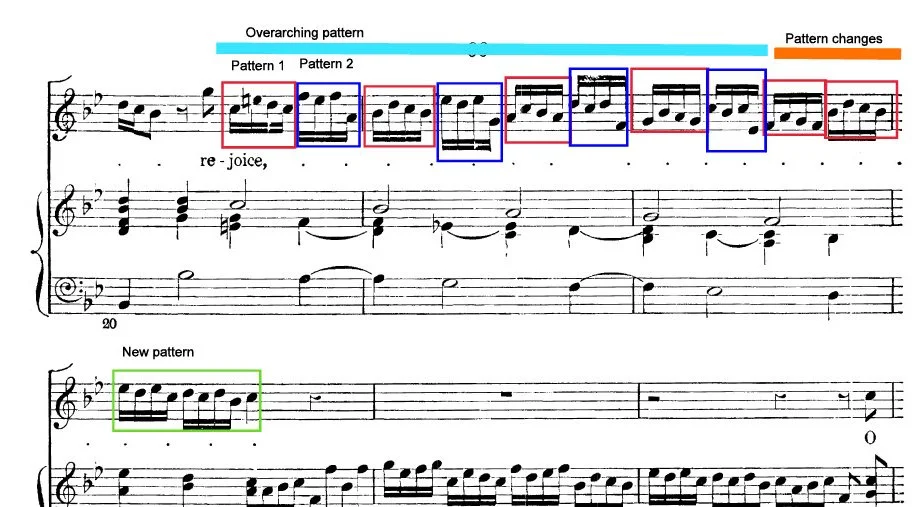How to Sing Fast
A quick guide for singers who want to improve their singing speed.
Most classically trained singers will come across repertoire with coloratura*. To some, coloratura is exciting and fun, to others it's the bane of their existence. If you fall into the latter category, I would love to help shift your perspective on singing coloratura because increasing the speed of your singing, though scary, is very possible. Below are a few actionable steps you can take to increase accuracy and control and decrease the fear of your many-noted phrases falling apart.
*Coloratura: “elaborate ornamentation of a vocal melody, especially in operatic singing by a soprano.” (Oxford)
Four Steps to Singing Fast with Clarity, Speed, and a Solid Sound
1.Learn the patterns and the underlying motion
Coloratura can be tricky not only because of the speed, but because of the note patterns within each phrase. Some phrases will have iterations of the same pattern (up 3 steps, down a third, and so on) through the entire phrase. Others will change each beat. Before you start singing, mark the patterns. I like to do this with brackets, but you can do so with highlighters or notation.
The underlying motion is typically going to be found on the big beat: what notes are on beat 1, 2, 3, and 4? That is your outline. Practice singing only those pitches to get a sense of where the phrase is headed. If you don’t know where it's going, you will likely get lost in the pattern.
Below is an example of a pattern breakdown from the first long coloratura passage in “Rejoice Greatly” from Handel’s Messiah. I have marked the beat patterns as well as the overarching patterns. You can do this off the beat too in order to practice different stresses. This is just a basic example. As suggested earlier, find the underlying motion first by singing only the FIRST note of each pattern. Notice that it is mostly 4ths that descend over the whole pattern? (C5-F5, Bb4-Eb5, etc)
2. SLOW IS FAST
One of the worst things we can do when learning to sing coloratura is to go straight into singing at tempo. Speed is the LAST step of this process. It will feel so boring, but in order to accurately sing the phrases on the breath and with full vocal fold closure (often referred to as adduction in voice science literature) you need to practice the phrases at least half speed. I cannot say it enough that slow is fast. Your voice will sound more full and you will be able to sing more fluidly at speed while still being in control.
Don’t try to sing beautifully the first (or even 10th) time through. You need to establish the notes, the direction, and where you are ending the phrase. No one wants to end their phrase with one beat too many…trust me.
3. Staccato is your best friend
The best exercise I've found to hit each pitch accurately and in tune is slow staccato. I like to use and [i] vowel (as in "eat") the first few times through, then switch to the vowel of the word in the passage. It's a quick and dirty way to improve your tuning of each pitch and will shine a light on any weak areas in the phrase.
4. Add Speed
Now that you have 1) broken down the patterns, 2) Sung it SUPER slow, and 3) Sung slowly on staccato to tune properly you might now begin to sing the phrase a little faster. Increase the speed by 5 bpm at a time (if you’re using a metronome, which I recommend). Any parts of the passage that feel messy should get special attention by starting these steps over. You may be working on 1 beat for several minutes in order to get it in shape. That’s ok! It’s part of the process.
This process itself takes practice and patience. The more you do it, the faster you can get through these steps. This is also not just for new pieces, you can rework old passages by taking them through these steps to really solidify how they feel and sound. There are many ways to sing coloratura and these are just 4 ways to get you singing more confidently and feel more in control. Feel free to iterate on these to find what works best for you!
Happy singing!
Need help putting these steps into action?
Meet the Author
Jennifer Burks is a professional voice teacher and soprano with over 17 years of formal training and degrees in Vocal Performance from the University of Arkansas and Vocal Pedagogy from New England Conservatory of Music (NEC). She is an active performer and has won prestigious vocal competitions such as the 2022 Rhode Island Civic Chorale. Beyond her studio, Jennifer is an active member of NATS, PAVA, and The Voice Foundation and is the incoming Auditions Chair of the New England Chapter of NATS. In her free time, she enjoys running, reading, sailing, and cherishing every musical moment.



